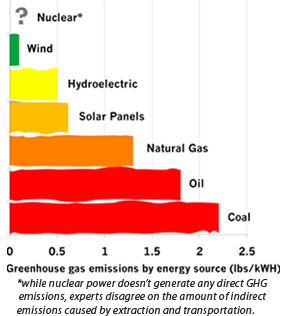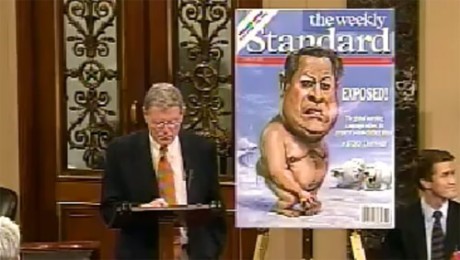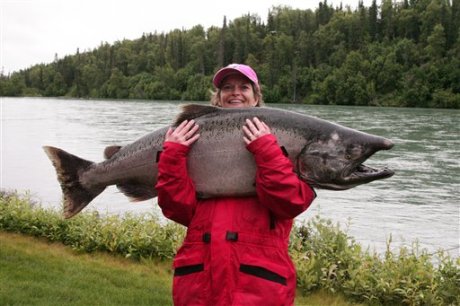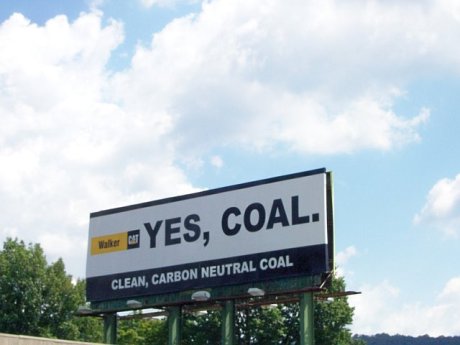Halliburton Tries to Greenwash Fracking November 17, 2010
Posted by Jamie Friedland in Natural Gas.Tags: 60 Minutes, Aubrey McClendon, Chesapeake Energy, CSI, EPA, Fracking, Greenwashing, Halliburton, Hydraulic Fracturing, Natural Gas
1 comment so far
Latest post at Change.org:
Some things just can’t be spun, but that doesn’t mean Halliburton won’t try. After being subpoenaed by U.S. EPA for refusing to reveal its drilling chemicals, the company announced it had developed a “green” fracking fluid sourced entirely from the food industry and promised to reveal the generic formula. That’s a start towards public disclosure, but far from good enough.
Full post here.
Republicans Block Anemic Energy Bill for Oil Industry July 28, 2010
Posted by Jamie Friedland in Climate Change, Congress, Offshore Drilling, Politics.Tags: Clean Air Act, Congress, Energy Bill, EPA, Fracking, Harry Reid, Inhofe, Jay Rockefeller, Lamar Alexander, Lisa Murkowski, Mark Begich, Oil Spill, Politics, Senate, ThePoliticalClimate
1 comment so far
Despite the weakness of the pending oil spill/“energy” bills introduced in the House and Senate this week, Big Oil and their Congressional allies are doing everything they can to make sure we do not learn from BP’s unforgiveable mistakes.
100 days after the Deepwater Horizon spill began, Republicans oppose each of the small shuffles down the right path that these bills contain.
For example, anti-science champion Sen. Inhofe (R-OK) takes exception with a provision that requires natural gas drillers to merely disclose which toxic chemicals they are injecting into the ground near our drinking water supplies during the controversial practice known as “hydraulic fracturing” or “fracking.”
Why does Inhofe oppose the simple disclosure of that information? Because Inhofe and the industry claim that the dangers of toxic chemicals in drinking water are overblown.
Comprehensive energy reform is already dead, and even these bills, which could only euphemistically be called “half-hearted”, have a slim chance because Republicans claim that there is little room for compromise. That is a disgusting claim. These bills are already grotesquely compromised. They were so thoroughly watered down in hopes of attracting the necessary supermajority that they are scarcely progress at all. To demand more compromise calls to mind a limbo player lying on the floor.
Republicans most vehemently oppose lifting the liability cap on oil companies that defile our nation’s environment. They say that expecting oil companies to pay for the full consequences of the damage they cause will drive “mom and pop” oil companies out of business. That is hardly a defense of limited liability: if that claim is true, perhaps mom and pop should pursue less risky projects.
Republicans are fighting to preserve the apparent right of every oil company, big or small, to remain blameless for the oil spills they continue to cause in American waters. That is senseless.
With midterm elections approaching, Republicans are pretending to have solutions of their own; toward that end, they are circulating an even bigger joke of an energy bill. Their “alternative” bill contains energy “solutions” such as lifting the deepwater drilling moratorium and preventing the administration from blocking offshore drilling again. You know, the change we need.
However, the Republican bill does contain a provision that unfortunately may influence the Democratic bills. Instead of unlimited liability for oil companies that cause spills (making them pay for all the damage they cause), Republicans have a different idea: ironically, the party of limited government wants to make the Department of the Interior set liability limits on each individual rig based on 13 different criteria, including a company’s safety record and the estimated risks involved with the specific location.
This is just another way to protect Big Oil and make sure that taxpayers are the ones who have to pay to clean up oil spills. Oil state Democratic Senators Mary Landrieu (D-LA) and Mark Begich (D-AK) are attempting to broker a compromise on oil spill liability.
There is one additional point that must be mentioned. Many Republicans are trotting out this line in various forms:
“This is a serious subject and it deserves consideration by the United States Senate on behalf of the American people. We are ready for a serious debate, but it appears the Majority Leader is not.” –Sen. Lamar Alexander (R-TN)
This complaint is not just about the bill’s expedited timeline. It is true that Sen. Reid is trying to have an energy bill passed by the August recess. Yet perhaps more importantly, Sen. Reid is unlikely to allow any amendments to be added to this bill.
Such a parliamentary maneuver is necessary because Sen. Jay Rockefeller (D-WV) is poised with his amendment to delay the EPA’s authority to regulate carbon dioxide under the Clean Air Act; the final regulatory bulwark of climate action in the United States.
Rockefeller’s amendment, about which I will write more soon, is similar to Sen. Lisa Murkowski’s (R-AK) “Dirty Air Act” amendment that was narrowly defeated in June. If amendments were allowed, she too would certainly poison this bill with something similar. Indeed, Murkowski is considering adding the amendment to an unrelated small-business bill as she tirelessly does the bidding of Big Oil in the U.S. Senate.
Why the EPA Should Regulate Carbon July 7, 2010
Posted by Jamie Friedland in Climate Change, Coal, Congress, Politics.Tags: Alan Blinder, Carbon Regulation, Climate Change, Coal, Congress, EPA, Global Warming, Jim Inhofe, Lisa Murkowski, Politics, Senate, Tailoring Rule, The Political Climate
1 comment so far
…because the Senate won’t.
Despite what is shaping up to be the hottest year on record, the ongoing oil spill and pubic opinion polls showing that Americans are finally ready to address our entwined energy and climate crises, legislation remains blocked by the usual suspects: Republicans, lobbyists and perpetual election year politics.
Most people think that Congress is the governmental entity that ought to address an issue as sweeping as climate change. I agree. So do most congressmen – loudly.
Unfortunately, many those congressmen who angrily rant about the importance of congressional authority are the very same people blocking congressional action.
The Obama Administration has made it clear that it does not want to have to regulate greenhouse gas emissions through the Environmental Protection Agency. Everybody would prefer that Congress pass a bill instead. The House has. The Senate, it seems, cannot.
Yet we must address a threat of this magnitude. So if Congress won’t, the EPA should. The Supreme Court agrees; if Congress doesn’t act, the EPA is legally obligated to regulate GHGs as a pollutant under the Clean Air Act. The EPA will not supersede legislative climate action; it will act in accordance with the Clean Air Act (written by Congress) unless Congress passes a newer law.
As the chances for such a law fade, it is worth examining what EPA carbon regulations might look like.
What Would EPA Regulations Looks Like?
There have been a number of bureaucratic hoops to jump through on the road to EPA carbon regulations. Next January, when the EPA’s new gas mileage standards for cars comes into effect, greenhouse gases will finally be “subject to regulation” under the Clean Air Act.
First, new polluting power plants and industrial facilities would have to adopt the “best available control technologies” (BACT) for regulating carbon emissions. The EPA gets to determine which technologies are “best.” Carbon capture and sequestration technology could fall into this category if it was proven, but that’s a long way off. In the meantime, the EPA would the mandate the use of existing technologies to reduce emissions and/or increase efficiency.
For example, the EPA could require any and all new coal-fired power plants to utilize integrated gasification combined cycle (IGCC) technology. IGCC plants convert coal into a synthetic gas so that it can be burned more cleanly (in terms of non-GHG pollutants) and use excess heat from the primary combustion and generation to power a secondary steam turbine that generates extra electricity per unit of coal burned. Or it could require new power plants use natural gas instead of coal.
Natural gas emits much less carbon than coal. It’s not a long-term solution, but significant short-term gains could be achieved by switching from coal to natural gas. The EPA could propose this change.
What is the “Tailoring Rule”?
Under the Clean Air Act, anyone trying to build or upgrade a facility that will emit a baseline level of a regulated pollutant (usually 100-250 tons per year) needs to get a permit from the EPA certifying that they are utilizing the “best available control technology” (BACT) to minimize their emissions.
For other Clean Air Act pollutants, like lead, 100 tons per year is quite a bit and well worth of regulation. The problem here is that carbon emissions are on a much larger scale. As the Clean Air Act is written, as many as 6 million buildings would need permits for their carbon emissions, including schools, churches, buildings that use heating oil…you get the idea. Not the real targets of these regulations.
In May, the EPA released its “Tailoring Rule” to limit the focus of the permitting process to facilities that release >75,000 tons of carbon dioxide per year and already apply for other Clean Air Act pollutant permits. This way, only the major polluters are subject to these regulations. The Tailoring Rule brings down the number of regulated buildings from 6 million to about ~550 of the biggest polluters.
For the record, when originally proposed, the cutoff was set at 25,000 tons per year, but after the comment period, the EPA realized that too many buildings would be unintentionally regulated (like schools and small businesses).
Additionally, any new power plants expected to emit more than 100,000 tons of GHGs per year would need to get a permit. This would certainly cover all new coal plants, whose emissions are on the order of million of tons per year.
If the EPA does end up implementing these regulations, conservative groups such as the U.S. Chamber of Commerce will likely challenge the Tailoring Rule in court so that schools etc. would need be regulated as well. Why? Because they hate children. …ok fine, because if the EPA enacts this policy, conservatives want it to become a regulatory nightmare. Making the EPA permit the 6 million buildings that emit much smaller amounts of carbon each year would be impossibly cumbersome and cause considerable public backlash – so conservatives hope we would just scrap the whole thing and let them keep polluting for free. Potential legal vulnerabilities such as this are a weakness of this less than elegant regulatory route.
Benefits of EPA Carbon Regulations
EPA regulations would hopefully be designed with less lobbyist influence than in Congress.
Most climate/energy bills – including the climate bill that pass in the House last year – end up “grandfathering” in some dirty coal plants. That is, their emissions are exempted from regulation. Such provisions completely undercut the energy bills that contain them by providing utilities with a perverse incentive to keep their oldest, most polluting plants open as long as possible. They are written by lobbyists and exist solely as thank you’s from American legislators to their industry supporters.
Disgustingly, even the original Clean Air Act grandfathered in existing coal plants.
Everything Congress touches that is at all energy-related comes out blackened with soot and covered in tar balls. The EPA is not impervious to industry demands, but it is certainly in a better position to stand up to industry than Congress (which isn’t saying much).
In fact, in many ways,
The EPA is Better Suited to Address this Issue than Congress
In 1997, economist Alan Blinder presented an interesting argument that some governmental challenges could and should be better solved by unelected experts.
Certain types of problems, Blinder correctly argued, are by nature better addressed by experts than by elected laymen in Congress. These types of problems meet three criteria (discussed below):
- The issue deals with technical subjects requiring specialized knowledge.
- The issue is long-term, both in problems and solutions.
- The issue imposes short-term hardship to avert long-term hardship of much greater magnitude.
Consider the legislative challenges of issues that meet these criteria. What follows are not critiques of our democracy but rather explanations of some unfortunate effects that institutional design can have upon policymaking.
Congress Lacks Specialized Knowledge:
Everybody knows that our elected representatives are not experts. They are elected to represent us and cannot possibly be expected to have in-depth knowledge of all the issues our legislature must tackle.
To overcome this deficiency, they summon experts to testify before them. But most testimony has little impact on legislation, and as anyone who has ever watched C-SPAN (or even the Daily Show) can tell you, sometimes “expert testimony” is nothing short of political theater.
For example, in 2005, the notorious Sen. James Inhofe (R-OK and Congress’s most vocal climate-denier), who at the time chaired the Environment and Public Works Committee, invited fiction author Michael Crichton to advise the Senate on climate science because he had recently written State of Fear, a fictional story about murderous eco-terrorists. Inhofe also made that book “required reading” for members of the top Senate environmental committee.
When you hear about the final deal-making and compromises being made to pass a law, it has nothing to do with expert testimony or pure policy considerations – it’s often just about pork barrel politics and a particular legislator’s demands.
It is easy to see why under certain circumstances, our country would be better served if experts in the field at hand were asked to craft sensible and efficient policies to address technical problems.
Congress Cannot Address Long-Term Problems:
It is never more than two years from an election year in Washington. If congresspersons want to be reelected, they need to deliver short-term results to their constituents.
It is no surprise, then, that long-term problems are not legislative priorities; they appeal to our legislators’ responsibility and duty, but those are not the forces that drive Washington.
Even if addressing a long term problem did not cost anything today, it would present an opportunity cost because a House representative only has 2 years to deliver demonstrably for his constituents.
For long term solutions that have short term costs, the future prospects grow bleaker. Add a degree of uncertainty and magnify it with disinformation and demagoguery, and it is obvious why climate bills are hard to pass.
Congress Cannot Impose Short-Term Costs for Long-Term Benefits:
Legislators are held accountable for the present, not the future. Until the end of their careers, the desire for reelection prioritizes short-term considerations. Think about a Representative in the House. If a bill in the House could save his constituents money in 10 years but will cost them money this year, he would have to be reelected 5 times before his constituents would feel the actual benefits of that bill, but he would surely be held responsible for the cost.
If that representative’s constituents are totally on board with that bill, they may give him credit for his work in the short term. But if it’s a contentious law and there is disinformation circulating, that vote could well cost him his job.
If the problem that bill solves is only a small one today, even if it’s going to get much bigger in the future, his constituents may resent him for imposing a cost to solve a problem that was not unbearable yet. This is why Congress is a reactive, not proactive, body.
Climate change is a long-term threat with long-term solutions. Unfortunately, we only have a short-term window to address it and it will impose short term costs.
It is the perfect storm of an issue that Congress really cannot handle. It is exactly the type of issue that Alan Blinder was talking about. That is why the responsibility of carbon regulation may well fall to the EPA.
Downsides to EPA Action
1. Limited Scope: EPA regulations, at least early on, would do very little to clean up our existing power plants. Recall from the Tailoring Rule that these regulations apply only to new or upgrading plants (unless they release other Clean Air Act pollutants too). Obviously, we would need to reduce our current emissions to meaningfully reduce our climate pollution.
2. Cost: Congressional action could achieve emission reductions more cheaply than the EPA regulations could. If EPA establishes carbon regulations under the Clean Air Act, they will be traditional “command and control” regulations. The EPA will dictate what emissions-reducing technologies are best, and mandate their use.
Instead of that approach, Congress could use more modern market-based initiatives like cap-and-trade to put a price on carbon. This would spur innovation and let us achieve our emission reductions for less. The EPA would mandate the use a current technology, with no incentive to develop better ones.
The cost factor and other differences between market-based initiatives vs. command and control regulations are outlined in this recent post.
3. It’s Not Enough: EPA carbon regulations would provide emissions reductions where we need them most – the energy sector. But they couldn’t put a price on carbon, which is a vital step to achieving the long-term reductions necessary to avert the worst effects of climate change.
“The only way to cut emissions 80 percent by 2050 is to put a price on carbon, and the only folks who can do that are in Congress.” –David Bookbinder, Sierra Club.
4. Threat of Being Overturned: Legal challenges could slow the EPA process but probably not derail it altogether. The real threat is that Congress could overturn anything the EPA does, as Lisa Murkowski has already attempted to do preemptively.
Conclusion:
By virtue of not having gone through Congress, EPA climate regulations would likely emerge looking more like a sound policy solution than anything Congress has ever produced. However, these regulations would not be enough. Combined with a good energy bill, they could be part of a real solution, but we would still need some congressional action to truly address this threat.
A comprehensive climate/energy bill would be preferable to EPA regulations. But if Senate conservatives block another climate bill, the EPA will take action. It will at least be a long overdue step in the right direction.
Climate Bill Skirmishes Pt. 1: The Murkowski Amendment June 15, 2010
Posted by Jamie Friedland in Climate Change, Congress, Politics.Tags: Big Oil, Bush, Climate Change, Endangerment Finding, EPA, GHGs, Global Warming, Lobbyists, Massachusetts v. EPA, murkowski, Obama, Republicans, Supreme Court
4 comments
Energy reform is long overdue for this country and it was on the legislative agenda even before BP sponsored 2010 as “Oil Drilling Risk Awareness Year.” The House of Representatives passed its climate/energy bill almost a year ago, and the Senate is finally preparing to attempt to follow suit.
The first skirmishes of the climate battle have already been fought in the Murkowski “Dirty Air” Amendment and a much less publicized incident regarding ocean acidification in the House of Representatives (which will be presented in a second post due to the unexpected length of this one).
Let’s start from the beginning. As you may know, in 2007, the Supreme Court ruled in Massachusetts v. EPA that greenhouse gases (GHGs) pose enough of a public health risk (via climate change) to be considered “pollutants” under the Clean Air Act.
That ruling imposed a legal obligation upon the EPA to do one of two things:
1) Either issue an “endangerment finding” that carbon dioxide poses a public health risk – and then regulate GHG emissions, or;
2) Provide proof that carbon dioxide is harmless. Such proof does not exist, so the Obama EPA issued its endangerment finding in November 2009.
There were two years between the Supreme Court ruling and the endangerment finding. Why? The Bush administration.
Jason Burnett was a former associate deputy administrator of the Bush EPA. The Supreme Court ruling came in April 2007. The following December, Burnett emailed the EPA’s conclusion that GHGs are pollutants to a White House office. When White House officials heard he was sending that email, they called him and ordered him not to send it. When he told them he already had, they actually demanded he recall the email (this can be done in some email programs). Burnett refused and resigned.
In June 2008, the New York Times discovered that because White House officials did not want to act on the information in that EPA email, they had simply never opened it. They just left it in their inbox, unread, with the justification that they didn’t have to act on the email if they hadn’t read it. That actually happened. And it was enough to delay climate action in the executive branch for years – until Obama’s election.
When Obama’s EPA finally released its endangerment finding last year, the ring wing threw a fit. Republicans had been enjoying decades of legislative success in blocking climate and energy reform, and here was Obama’s tyrannical executive branch finally putting the nation’s interests first and actually acting against a grave threat. How dare they?
Congressional Republicans were particularly angry about the endangerment finding because it could supplant congressional authority [not] to legislate on the issue. So last January, Sen. Lisa Murkowski (R-AK) introduced an amendment to reverse the EPA’s endangerment finding.
For a senator with such a proven history of representing the oil industry, it seems like a basic piece of legislation: the endangerment finding gives the EPA the authority and obligation to act, so her amendment seeks simply to overturn the ruling to remove that impetus. But consider what she was actually attempting to do.
The endangerment finding is a nonpartisan summary of science. All it says is that a warming climate caused in part by human emissions of GHGs will present a public health and welfare risk. That’s it. No policy prescriptions, just scientists warning about a scientific danger.
Obama and Bush have very, very different stances on climate change. Yet the Obama administration’s endangerment finding is very similar to the one that was produced and then buried by the Bush administration (it was released last October by a Freedom of Information Act request). The science is settled. Sen. Dick Durbin (D-IL) correctly described the Murkowski amendment as, “a choice between real science and political science.”
The Murkowski “Dirty Air” Amendment sought to grant Congress the authority to determine what is scientifically true in our world. It is the most inappropriate piece of legislation I have ever seen. Moreover, it was a reprehensibly transparent demonstration of the level of industry involvement in our legislature – the Murkowski amendment was literally written by lobbyists for the oil industry!
“Who elected the Environmental Protection Agency?” asked a furious Sen. John Barrasso (R-WY). Answer me this, John: who elected the oil lobbyists who wrote this amendment? Scientists are qualified to address scientific concerns. If scientists tell us carbon dioxide is irrefutably a pollutant, that point should be legislatively unimpeachable. I should never have had to make that point. The only people overstepping their bounds here are the senators who voted for this amendment. And they’re doing it to preserve their right to continue shirk their duty to that electorate Barrasso pretends to care so much about.
The measure came up for a vote last week. It failed, but barely: 53-47. Every Republican and six Democrats* voted for the amendment. And more Democrats than that expressed support for this resolution before cowing to party pressure. Sen. Rockefeller (D-WV) even has his own pending version of the proposal that would undermine EPA authority for (at least) two years.
*Landrieu (D-LA), Lincoln (D-AR), Pryor (D-AR), Nelson (D-NE), Bayh (D-IN), Rockefeller (D-WV).
In reality, the Murkowski amendment was never going to become law. It had very little chance of getting through the House, and even if it miraculously did, it would have met an Obama veto. Everybody knew that, including Murkowski. This was grandstanding.
Most people, even within the administration, don’t want the EPA to have to regulate carbon dioxide. There is general agreement that Congress should be the body to address an issue as big as climate/energy. Politically, this EPA action just puts a deadline on Congress…a much-needed deadline, as they have postponed this issue for decades. It also manufactures a talking point for Glenn Beck et al. about Obama’s plan to take over the country.
Conservatives who oppose progress have concluded that delay and doubt are more successful strategies than full denial. That’s why Republicans always call for “more research” and tell Democrats they need to “go back to the drawing board” whenever we actually try to tackle an issue. You saw it for healthcare reform and you will see it again for climate. It lets them pretend to care about the issue in general and claim to just have problems with the specific way that Democrats are doing it.
But, like healthcare and a host of other issues, climate change is a threat that has already been put off for too long. We must act now if we are to have any chance of preventing this crisis. Congress has had ample time to act on this issue. At some point, enough is enough. If legislators refuse to take action yet again, it is fully appropriate for the EPA to do so. In fact, they are obligated by law.
The Murkowski amendment was the first round of this year’s climate battle. And it demonstrates what a tough fight we have ahead.
This was not a bill to regulate GHGs. The implications were clear, but no specific proposals were included here. There were no numbers to argue about, no regional winners and losers yet. This was an argument about whether or not to pass a law at all. And the actual amendment didn’t even go that far – it was basically just a congressional rejection of climate science. And it nearly passed.
BP – and Oil – Sinks to New Lows May 24, 2010
Posted by Jamie Friedland in Media, Offshore Drilling, Politics.Tags: BP, Brit Hume, Corexit, Deepwater Horizon, Dispersant, EPA, Nestucca, Oil, Oil Spill, Oil Spill 2010, Rush Limbaugh
4 comments
***TWO UPDATES: 1) The EPA may be backtracking a bit? I do not see why. 2) BP has revised its earlier claim of having siphoned 5000 barrels per day (bpd) from the spill. It was actually 2,200. BP spokesman John Curry: “The flow changes, it’s not constant.” Neither is your story.***
As you may know, the EPA recently ordered BP to discontinue its use of the dispersant Corexit 9500 on account of its toxicity. They gave BP 24 hours to choose one of the 18 other readily available and less toxic dispersants, and gave them 72 to stop using Corexit.
BP has refused. Why? We don’t even know. BP has actually threatened to invoke “trade secrets” to stop the EPA from showing its written response to the public! On top of all that oil, BP had pumped 715,000 gallons of toxic dispersant into the Gulf as of Sunday, and they want to continue.
So just what do these dispersants do? They break apart the oil into smaller droplets. When dispersed into smaller droplets, oil is slower to rise in the water column – it may stay suspended for weeks or even sink. This can protect some beaches for a while, but it greatly increases the impact on the aquatic ecology.
During the 1988 Nestucca spill in Canada, oil appeared on 100 miles of shoreline two weeks after the spill. Oil does naturally degrade, but submerged oil weathers more slowly than surface oil. As a result, relatively fresh oil can travel hundreds of miles from the spill. There is also no good technique to remove submerged oil because skimming is impossible.
Aside from trying to keep oil off beaches, breaking the oil into smaller droplets facilitates its degradation by aquatic bacteria. However, even when this process works, the added activity of those microbes sucks all the oxygen out of the water, leaving it a hypoxic dead zone incapable of supporting life anyways, even if it is less oily.
I’m not saying that dispersants don’t have the potential to reduce some of the environmental damage. It is a tradeoff in the lose-lose scenario oil spills are. But the only certainty here is that BP, not the environment, benefits most from the use of dispersants.
A growing group of conservative figureheads, including Rush Limbaugh and Brit Hume, are rapidly earning the title “oil spill denier.” They have been challenging the reported scope of the ongoing oil spill (even though it is without a doubt being underestimated) with one simple question: “where is the oil?”
The oil slick isn’t as big as it ought to be. The size of the surface spill does not match any realistic estimates of the spill rate. And that won’t change on BP’s watch.
We have known for over a week that this apparent discrepancy is explained by vast quantities of oil discovered lurking suspended in the water column. However, these plumes are difficult to monitor and impossible to measure. The only way to truly know how much oil is there is to know how much was released. That would mean accurately measuring the flow rate of the spill.
More on oil plumes and what’s happening underwater here.
BP says it is impossible to measure that flow. This is false. In BP’s own regional plan for offshore oil risks, page 2 of 583 reads: “In the event of a significant release of oil, an accurate estimation of the spill’s total volume…is essential in providing preliminary data to plan and initiate cleanup operations.”
That’s on paper. In practice, we know that BP has not only refused to make that measurement itself, it has tried (and largely succeeded) to block scientists from making the calculations themselves. Additionally, in direct hypocrisy with its own plan, BP spokesman Tom Mueller explained that no further efforts to estimate the rate would be undertaken because “it’s not relevant to the response effort and it might even detract from the response effort.” Lies.
It is astounding to me that in this day and age, anyone could even consider attempting to withhold this kind of information and lie so boldly. What is more infuriating is that so far BP has succeeded.
Since the first few days of this spill, BP has stuck to its 5,000 bpd (barrels per day) estimate even while all other sources indicate the spill may be as many as 24x greater than that. BP only admitted they maybe their estimate is a LITTLE low when they siphoned 5,000 barrels from the spill in one day – without capturing anywhere near all of the escaping oil. Go figure.
Yet they still assert that that figure is largely accurate. How? Because BP has decided to estimate the spill rate by the size of the surface slick. This is why BP loves its dispersants: to BP, every gallon of oil that remains beneath the surface is a gallon of oil that NEVER SPILLED. And until the Obama administration allows them to control what information is released, their estimate (in the media’s eyes) remains the most authoritative.
Low-balling the spill estimate is not just a PR victory for BP. A low estimate of this spill’s size could save BP millions in court. Even uncertainty helps them in that regard. The industry learned lessons from the Exxon Valdez spill too, and the inability to precisely measure how much oil was released limited the damages that could be assessed.
I was wrong – it is now clear that BP has a conflict of interest in nearly every facet of this containment effort. They are unfit to lead this effort and must be removed. Such action cannot release them of ANY responsibility for what has and will still happen, but they cannot lead any longer.
Full list of oil spill questions and answers here.
Oil Execs Testify Before Congress…Technically May 11, 2010
Posted by Jamie Friedland in Offshore Drilling, Politics.Tags: 2010 Oil Spill, BP, cantwell, Congress, Deepwater Horizon, EPA, Gulf of Mexico, Halliburton, ixtoc, landrieu, menendez, Montara, murkowski, Offshore Drilling, Oil, Oil Spill, Senate, sessions, testimony, Transocean
3 comments
In case you didn’t have the pleasure of watching executives from BP, Halliburton and Transocean testify before Congress Tuesday afternoon, I have compiled some highlights and thoughts below.
The testimony in the U.S. Senate Committee on Energy & Natural Resources was revealing in how little it revealed. If we are to learn from and respond to this tragic event, people will have to start changing their tunes. As of today, they have not. I mean that in respect to both the oil executives and many of our U.S. senators. We’ll do the Big Oil execs first, then get into the senators.
First, the Big Oil execs:
If you have watched this kind of congressional testimony before, you know it is the world’s most boring dance. Senators ask questions, and those testifying carefully choose their words to convey as little as possible – or claim memory loss. Sometimes a senator will pursue an answer, but rarely does that actually extract the desired truth.
The only questions Big Oil actually answered today were those that Google could just have easily have answered, such as “is your company the largest offshore drilling contractor?”
Corporate legal teams carefully prep their executives to legally dodge the most damning questions. That preparation, which largely defeats the purpose of these hearings, was on notable display twice this afternoon.
For over a week now, BP has said it is prepared to pay “all legitimate claims.” They’ve been talking a big game about how they plan to repay their victims.
Conveniently, BP has yet to define exactly what claims it considers “legitimate.” They are unlikely to do so until they are taken to court. In his testimony, when pressed on this question, BP America President Lamar McKay did nothing but repeat that deliberately ambiguous phrase.
When general prodding from several senators went unanswered, Sen. Maria Cantwell (D-WA) finally tried to hold BP accountable. She went down a list of likely claims against BP. McKay’s response was the same nearly every time: “all legitimate claims.”
“1) Shrimpers who can’t earn their livelihoods?”
“We will pay all legitimate claims.”
“2) Beaches spoiled, tourism ruined?”
“All legitimate claims.”
“3) Children sickened by oil fumes?”
“All legitimate claims.”
Ad nauseam.
To top it off, McKay had the gall to follow up this laughable interaction with a preposterous assurance: “this is not about legal words, it’s about getting it done and getting it done right.” No, sir, this is PRECISELY about legal words. Please refrain from lying under oath, Mr. McKay. It’s frowned upon.
The second most odious exchange of the hearing was when Transocean President and CEO Steven Newman was asked if this type of spill had happened before. He replied that the only incident he could recall was the Ixtoc spill. To his credit, that spill was the worst of this type, but this answer is incredibly deceitful.
You’re trying to tell me that that Steven Newman, presumably a lifelong oilman, the president and CEO of an offshore drilling company that specializes in deepwater drilling, has to go back 31 years to recall an incident like this one? I’ve never worked in the oil industry and even I know that THIS TYPE OF SPILL HAPPENED 8 MONTHS AGO (Halliburton is suspected to have caused that one too)! In fact, even the photographers in that hearing room knew about the Montara spill: Sen. Menendez brought it up earlier in this very hearing!
Note that the response was deliberately and delicately phrased (“the only incident I can recall“) so as to avoid committing perjury.
Even as oil is gushing into the Gulf of Mexico, the oil industry and their congressional allies are STILL trying to cast offshore drilling as a safe practice. This spill was not unconceivable and not unprecedented. Senators and oil executives repeatedly called this accident “unique.” The only thing unique about this oil well was that it was in even deeper water and even deeper underground than usual, so all the real risks associated with drilling and the complications of containment and cleanup for spills were MAGNIFIED!
It is also worth mentioning the conduct of the senators present:
The oil executives weren’t the only ones choosing their words carefully. When I tuned in, Sen. Lisa Murkowski (R-AK) had the microphone. She was going to great lengths to avoid saying the words “oil” or “spill.” She even referred to the Exxon Valdez “incident.” This type of disingenuous wordplay is normally reserved for company spokespeople. Sadly, this is par for the Murky course.

Lisa Murkowski (R-AK): It is difficult (although sadly, not THAT difficult) to find a U.S. senator doing LESS for the American people and more for industry special interests.
Murkowski is often derisively labeled as (R-OIL) because of her industry ties. It is her “dirty air” amendment in the Senate that is attempting to strip the EPA of its authority (and indeed Supreme Court-issued mandate) to regulate carbon dioxide under the Clean Air Act. It came as little surprise when news broke early this year that the amendment had not been written by the senator’s staff but rather by oil industry lobbyists themselves. She was merely their mouthpiece. The things money can buy.
In her opening statement, Murkowski, the ranking minority member of the committee, explained why we need domestic oil drilling: “for the sake of our nation’s economy, for the sake of our national security, and this incident not withstanding, for the sake of our world’s environment.” The economic and national security impacts of domestic offshore drilling have long been shown to be literally negligible, but I am genuinely curious to hear how this congressional oil flack would spin drilling as anything short of toxic for “our world’s environment.” Too bad Murkowski wasn’t under oath too.
Sen. Jeff Sessions (R-AL) also took the opportunity to extol the virtues of domestic offshore drilling. I would tell you more about his questioning, but I really don’t think I could. When he had the microphone, I almost felt sorry for the industry executives; he never really put together a coherent sentence. The inflection in his voice was raised when he stopped talking, and he clearly expected them to respond, but I didn’t even understand what he expected of them. How fortunate, then, that the executives were coached not to give actual answers anyways.
Sen. Mary Landrieu (D-LA) was talking tough for her state. She is in a fierce primary against a much more liberal opponent, Lt. Gov. Bill Halter. But all her barking is election-year antics. No congressperson receives more money from the oil industry than Landrieu, and she continues to push the lie that offshore drilling is vital to our country – even as oil begins to wash up on Louisiana beaches. Her priority is making sure BP pays her voters quickly enough that she will be reelected to continue to act against our country’s best interests.
Sen. Robert Menendez (D-NJ) and Sen. Maria Cantwell (D-WA) were on point and champions. They asked piercing questions and did their best to take the executives to task and get actual answers. Yet there is only so much one can do within this broken system.
Having watched some testimony before, I know that these proceedings were not that unusual. To me, this is not a defense of what transpired today but rather more proof that business as usual must change if we to move forward as a country, both in the context of this tragedy and more broadly. Congress is an inertial body, but a catastrophe of this magnitude demands action.
Full list of oil spill questions and answers here.
Dethroning King Coal December 1, 2008
Posted by Jamie Friedland in Climate Change, Coal.Tags: CCS, Clean Coal, Clean Water Act, Coal, Coal Mining, Corruption, Don Blankenship, Environmental Protection Agency, EPA, George W Bush, Massey Energy, Mountaintop Removal, NRDC, Pollution, Walker Machinery, West Virginia
3 comments
Last month I was fortunate enough to drive through – and not stop in – the lovely state of West Virginia. It was dark, but between the mountain passes I did get to do some sightseeing. I was impressed by the neoclassical grandeur of the state capitol building, but I was also treated to pollution-belching industrial complexes beautifully backlit by gas flares. The scene was reminiscent of, but did not smell quite as bad as, Gary, Indiana – a real gem in a state that prides itself on being “The Crossroads of America” (read: between places worth visiting). But I digress.
Drifting somewhere between “the zone” and highway hypnosis, I was jarred awake by a billboard just past Charleston. It said, “YES COAL. Clean, carbon neutral coal. ” I slammed on the brakes so hard I was nearly rear-ended as I slowed to make sure I’d read correctly. ‘Clean’ is already a sleazy misnomer for coal, but ‘carbon-neutral’? That sign’s not just wrong, it’s probably illegal: There are laws protecting the public from false advertising.
There is no way to burn coal without releasing its carbon. That’s just how combustion works. The only way that billboard is not a blatant mistruth is as a deceitful allusion to carbon capture and sequestration (CCS) a process that theoretically would allow us to catch carbon dioxide as it’s emitted. But CCS is expensive and has yet to be practically implemented, so coal remains our most carbon-intensive (and dirtiest) energy source.
Walker Machinery, the mining equipment supplier responsible for this and other misleading coal ads, even admits on its Web site that its statements refer to the [ideal] future of coal, not the present. And that dirty present has gotten some attention lately.
One of Walker Machinery’s major customers is Massey Energy, the nation’s fourth-largest coal company. Massey has received a lot of negative press. In 2006, notorious CEO Don Blankenship was sued with Massey when his unrelenting emphasis on coal production over safety led to two deaths in a mine fire. Last year, Massey was sued for committing up to $2.4 billion worth of violations of the Clean Water Act. And this year, two West Virginia Supreme Court Justices had to recuse themselves from a case against Massey after photos surfaced of one vacationing with Blankenship on the French Riviera. The court, led by a third justice on whose campaign Blankenship spent $3.5 million but who has still ruled on numerous cases about Massey, voted to overturn a previous $77 million verdict against the company (see video below).
ABC’s Nightline reports on Don Blankenship. Check this out.
How has Massey responded to its criticism? Blankenship unloaded on coal critics last week at the Tug Valley Mining Institute, calling them “communists,” “atheists” and “greeniacs.” He then compared environmentalists to Osama bin Laden. But my favorite quote was, “Most people wouldn’t believe that coal is the most important thing to the environment. ” I’ll provide some context lest that sound silly: the environment to which he was referring was the “total environment,” which is composed not just of “trees and all that” but also of the ability to send our children to school.
Oh, that environment…wait, what?
Blankenship’s rant went on to sympathize with like-minded people who don’t believe in climate change but are “afraid to say that because it is a political reality.” Without exploring the remarkable similarities between his “political reality” and our “actual world,” I’d just like to say I hope that in this new political era we can set aside pesky realities and embrace fanatical utopias where ignoring something hard enough makes it magically disappear. Viva la status quo!
But coal executives like Blankenship have reason to be cranky these days. Two weeks ago, the Environmental Protection Agency ruled that utilities must apply the best available control technology for carbon dioxide emissions at new coal-fired power plants. This really just updates EPA policy to start treating CO2 like other pollutants, but it has serious implications for the future expansion of coal power – unless they can show us some clean, carbon-neutral coal plants.
Yet the Bush bonanza is not quite over. The EPA ruled against utilities, but coal mining continues as usual. And according to a blog post by Rob Perks at the Natural Resources Defense Council, the EPA is soon expected to weaken environmental regulations on toxic mining waste. The governors of Tennessee and Kentucky have opposed this assault on their states’ water quality; West Virginia Governor Joe Manchin has not, tacitly upholding his state’s submission to the coal industry at the expense of environmental and public health.
Just last week Massey Energy received approval to flatten another West Virginia mountain in search of coal. Local citizens are pleading with the governor to rescind the permit, claiming that the mountain has enough wind potential to cleanly power up to 150,000 homes. Would it be so terrible for West Virginia to invest in some renewable energy and preserve the mountains that drive its valuable tourism? That would certainly be a step in a new direction.
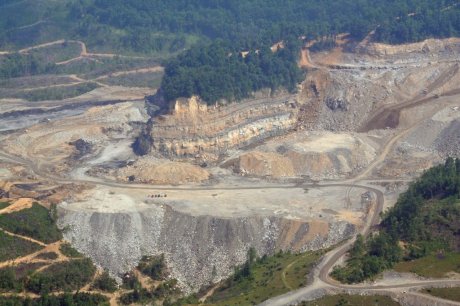
This used to be a mountain before coal mining. For a sense of scale, those are 6 cars just left of center in front of that road across the middle.
Governor Manchin, when it gets so bad that passing college kids feel comfortable casually deriding your entire state, maybe it’s time for a change. America already has a Gary, Ind. Why don’t you help keep West Virginia “Wild and Wonderful” by leaving a few of its mountains intact?
A version of this post ran in The Chronicle at Duke University.
That Sinking Feeling November 17, 2008
Posted by Jamie Friedland in Climate Change.Tags: Bush, Climate Change, Corruption, Environmental Protection Agency, EPA, Exxon, Global Warming, Jason Burnett, Maldives, Politics, Stephen Johnson
1 comment so far
In April 2004, President Bush was visibly stumped when asked to name his biggest mistake since 9/11. Last week, he was asked the same question again. He is no longer speechless, but he still has no substantive answer – when pressed, he said he wished he’d phrased a few things more “artfully,” without naming a single action he regrets (video). A certain president-elect may be able to think of a few.
I am referring, of course, to President-elect Mohamed Nasheed of the Maldives. Located off India’s southern coast, the Maldives is composed of 1,192 islets, about a quarter of which are inhabited. It is also one of the island nations that will be the first victims of rising sea levels.
Sea levels have risen about 8 inches in the last century as a result of melting terrestrial ice and the thermal expansion of warming seawater. The Intergovernmental Panel on Climate Change, the scientific authority on global warming, projects that sea levels could rise up to two feet higher by the year 2100. That may not seem like much, but for a country whose highest point is 7.5 feet above the water (with most ground well below that), this is cause for concern. Especially when you consider that after the 2004 earthquake that unleashed tsunamis around the Indian Ocean, 82 people died and the Maldives suffered $375 million in damage – when it was struck by a wave barely a meter high.
As anyone who’s ever tried to defend a sandcastle from the tide knows, the ocean is pretty difficult to stop and normally wins. And Mr. Nasheed has apparently spent some time playing on his country’s vanishing world-class beaches. In order to secure the future of his people, he recently announced that he will set aside a portion of the Maldives’ tourism revenue to establish a fund. With this money, he plans to buy land in India, Sri Lanka or Australia as an “insurance policy” for the nearly 400,000 Maldivians should their country succumb to the effects of climate change.
Who is responsible for this climate crisis? Many people (myself among them) say the United States. Although it would be unfair to blame climate change solely on our current president, the Bush II administration has certainly contributed. In 1988, George H. W. Bush said, “Those who think we are powerless to do anything about the greenhouse effect are forgetting about the White House effect.” But he could not have imagined just how powerful that White House effect could be. Or that it would be used to preserve the dangerous status quo.
For the last eight years, politics have unequivocally trumped science, even at the Environmental Protection Agency. In 2001, Bush picked Philip A. Cooney to be his chief of staff for the White House Council on Environmental Quality. Cooney, who had no scientific training and previously worked for the American Petroleum Institute (the oil industry’s main lobbying group), was soon discovered to have edited and removed sections of finalized government research to make climate change seem less serious. Cooney resigned two days after his actions were exposed – and promptly took a job at Exxon. Sadly, this was not an isolated incident.
Documents obtained through the Freedom of Information Act show that White House officials consulted with Exxon for advice before Bush rejected the Kyoto Protocol. A House of Representatives committee report in 2007 found that the Bush administration has edited congressional testimony on climate science and key legal opinions, and kept scientists from talking to reporters. And despite the unanimous recommendation of his advisers, EPA Administrator Stephen Johnson denied California’s waiver to implement higher vehicle emissions standards after reportedly being pressured by Bush himself. This denial was completely unexpected and unsupported; EPA officials scrambled pitifully after the fact to assemble some sort of justification, which is currently under investigation.
But the most incredible story comes from Jason Burnett, a former associate deputy administrator of the EPA who resigned this summer. In April 2007, the Supreme Court ruled that greenhouse gases are a pollutant and as such must be regulated. The following December, Burnett emailed a White House office the EPA’s proposed rule to limit emissions. When officials heard he was sending that email, they called him to order him not to send it. When he told them he already had, they actually demanded he recall the email (this can be done in some programs). He refused. In June, the New York Times discovered that because White House officials did not want to act on the information in the EPA email, they simply had never opened it. They just left it in the inbox with the justification that they don’t have to act since they haven’t read it (The Daily Show reports).
This is the kind of administration I cannot wait to see leave.

Bush at the G8 Summit in Toyako. As he left, he said "Goodbye from the world's biggest polluter!" and, in the words of Britain's Telegraph, "punched the air while grinning widely." Seriously.
Climate change is real and largely our fault. I don’t agree with all of President-elect Obama’s environmental policies, but I do look forward to having a leader who actually understands the threats we face and will treat them with the gravity that they deserve. And just in time: neither the Maldives nor America can afford any more of the same.
A version of this post ran in The Chronicle at Duke University.
